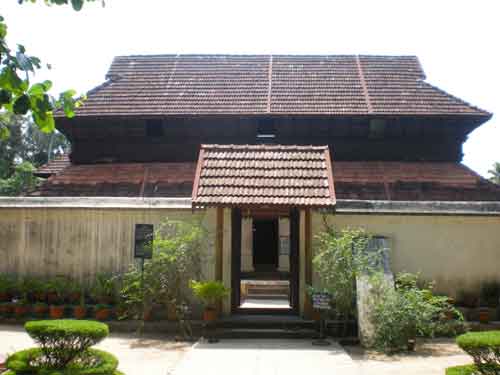The Krishnapuram Palace is a palace and museum located in Kayamkulam near Alappuzha in Alappuzha district, Kerala in southwestern India. It was built in the 18th century by Anizham Thirunal Marthanda Varma (1729–1758 AD), the Travancore kingdom. It is built in the architectural style of Kerala with gabled roof, narrow corridor and dormer windows, near the Krishnaswamy Temple at Krishnapuram.Within the palace is the archaeological museum which has an exhibit of the Gajendra Moksham a 3 metres (9.8 ft) high mural, which is the largest single piece of mural painting so far discovered in Kerala. The literal meaning of ‘Gajendra Moksham’ is the “salvation or Mokshaof the elephant king Gajendra.” The theme of the mural is mythological and depicts an elephant saluting Lord Vishnu in devotion while the other minor gods, goddesses and saints look on. Lord Vishnu was the family deity of the Kayamkulam Kings. This mural, in a fusion of colours and expressions, was placed prominently at the entrance to the palace from the pond to enable the kings to worship the deity after their daily ablutions.
The mythological legend narrated on the Gajendra Moksham (Gajendra means the King of elephants) is contained in the 10th century Sanskrit Bhagavata Purana. According to this legend, the Pandyan King Indradyumna, a devotee of Lord Vishnu, was given a curse by the sage Agastya, to be reborn as an elephant. Gajendra or the Elephant King, while on a pleasure trip to a lake with his wives, was seized by a crocodile that caught hold of his leg with a firm grip and thus Gajendra was held captive for many years. Finally the hapless Gajendra appealed to Lord Vishnu, his chosen deity, to rescue him from his predicament. Vishnu made his presence soon after, riding on his Vahana (vehicle), the Garuda (the celestial half man half bird form). Garuda killed the crocodile. The entire sequence is vividly painted, with vegetable colours, on the mural with a dynamic portrayal of Garuda at the centre, about to land with “huge spread wings and a facial expression raudra (form of fury), in stark contrast to the compassionate features of the multi-armed Vishnu”. The mural also shows a smaller figure of Gajendra in mid-trumpet, and of the crocodile on the right side. The mural truly represents the Kerala style of painting on every available space on it. Apart from the main characters of the legend, saints, animals, mythical beasts and forest plants are also depicted. The outer edges of the mural are decorated with Floriate borders. At the bottom, there is an exclusive “triptych-like panel which depicts Balakrishna, the child Krishna surrounded by doting females.

The mythological legend narrated on the Gajendra Moksham (Gajendra means the King of elephants) is contained in the 10th century Sanskrit Bhagavata Purana. According to this legend, the Pandyan King Indradyumna, a devotee of Lord Vishnu, was given a curse by the sage Agastya, to be reborn as an elephant. Gajendra or the Elephant King, while on a pleasure trip to a lake with his wives, was seized by a crocodile that caught hold of his leg with a firm grip and thus Gajendra was held captive for many years. Finally the hapless Gajendra appealed to Lord Vishnu, his chosen deity, to rescue him from his predicament. Vishnu made his presence soon after, riding on his Vahana (vehicle), the Garuda (the celestial half man half bird form). Garuda killed the crocodile. The entire sequence is vividly painted, with vegetable colours, on the mural with a dynamic portrayal of Garuda at the centre, about to land with “huge spread wings and a facial expression raudra (form of fury), in stark contrast to the compassionate features of the multi-armed Vishnu”. The mural also shows a smaller figure of Gajendra in mid-trumpet, and of the crocodile on the right side. The mural truly represents the Kerala style of painting on every available space on it. Apart from the main characters of the legend, saints, animals, mythical beasts and forest plants are also depicted. The outer edges of the mural are decorated with Floriate borders. At the bottom, there is an exclusive “triptych-like panel which depicts Balakrishna, the child Krishna surrounded by doting females.

